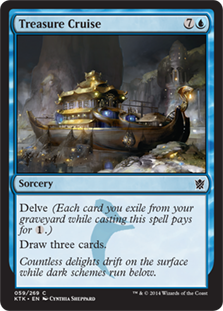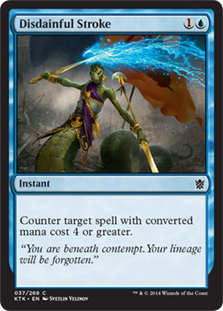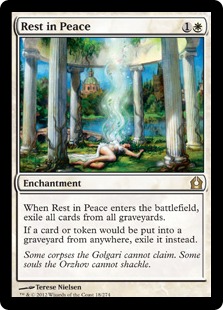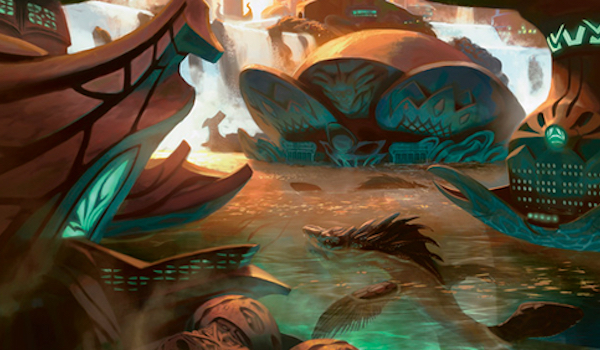Are you a Quiet Speculation member?
If not, now is a perfect time to join up! Our powerful tools, breaking-news analysis, and exclusive Discord channel will make sure you stay up to date and ahead of the curve.
Move over, Shiloh---It's Modern season! The next few weeks in my calendar are full of Modern PPTQs, Opens, and GPs, and I think I finally know what to sleeve up. Two weeks ago, I introduced Traverse Delver, a mid-game-focused, Traverse the Ulvenwald/Bedlam Reveler-powered grow deck that finally solved Temur Delver's miserable Jund matchup. It did so for a hefty price: weakening Monkey Grow's highly favorable linear matchups.

My current iteration of the deck runs a traditional Monkey Grow configuration in the mainboard, and sideboards into Traverse Delver. This article unveils that deck and discusses its current metagame positioning, which I believe to be phenomenal.
Threshold and Super Grow
We'll start with some history. Legacy's Canadian Threshold exemplifies a modern grow deck. Threshold wants to deploy a threat, then trade off resources to keep opponents from casting the cards in their hands, all while attacking every turn and protecting its creature from removal. If all goes well, by the time opponents manage to neutralize the assault, the board will look as though it's still turn two, and opponents will be sitting at around six life. That's low enough for Threshold to Brainstorm into some Lightning Bolts and finish the game.
Creatures in general are much better now than they used to be. Threshold plays some of the most efficient threats in the game: Delver of Secrets, Tarmogoyf, and Nimble Mongoose. The deck it grew out of, Miracle Grow, used to supplement Mongoose with Werebear and Quirion Dryad. But Miracle Grow had its own huge benefit: a highly efficient source of card advantage.
 Super Grow describes a grow deck that can transition to a control gameplan by converting an unused resource (i.e. land drops or cards in the graveyard) into cards. Extended Miracle Grow, Vintage Gro-A-Tog, and Legacy/Modern Treasure Cruise Delver are all shining examples of once-legal Super Grow decks. As anyone who played Legacy while Treasure Cruise was legal can attest to, giving one of the format's best decks (URx Delver) a way to turn its enormous graveyard into more cards just breaks the archetype. Canadian Threshold is great against linear decks but can be ground out by fair decks like Punishing Jund or Miracles; with a card like Gush or Treasure Cruise, it suddenly can't.
Super Grow describes a grow deck that can transition to a control gameplan by converting an unused resource (i.e. land drops or cards in the graveyard) into cards. Extended Miracle Grow, Vintage Gro-A-Tog, and Legacy/Modern Treasure Cruise Delver are all shining examples of once-legal Super Grow decks. As anyone who played Legacy while Treasure Cruise was legal can attest to, giving one of the format's best decks (URx Delver) a way to turn its enormous graveyard into more cards just breaks the archetype. Canadian Threshold is great against linear decks but can be ground out by fair decks like Punishing Jund or Miracles; with a card like Gush or Treasure Cruise, it suddenly can't.
I'm not saying Bedlam Reveler will "break" the Tier 3 deck that is Temur Delver. In fact, as far as draw engines that slot into grow decks go, it seems incredibly balanced. I'm just saying it gives us access to a toy historically dangerous in grow decks. Key differences to note are that including Bedlam Reveler in the mainboard cuts into valuable disruptive spots and pushes us more firmly in the direction of midrange. Since Reveler can't be cast until the graveyard is full of instants and sorceries, it's lousy at clocking fast, linear decks. But it is superb against midrange.
[wp_ad_camp_1]
A Moment of Clarity
I'd be lying if I said Traverse the Ulvenwald and Bedlam Reveler didn't make me delirious. Brewing always gets me excited, but the prospect of a suddenly favorable Jund matchup had me euphoric. With Jund solved, I figured I had something unbeatable on my hands, and jumped into a series of competitive events with Traverse Delver. My results at these events, in which I never managed to crack Top 8, revealed a few things to me.
Problem: Interacting With Linear Decks
Skewing Temur Delver's mainboard so heavily to fit Reveler severely impacts our linear matchups. Hooting Mandrills  and Stubborn Denial were integral to fighting Modern's many linear decks. With a drastically improved Jund matchup came noticeable slips against opponents itching not to interact. No longer could I laugh in the face of Tron, for whom I now had to sleeve up Disdainful Stroke; gone were my days of effortlessly crushing Burn, which now incentivized me to run Feed the Clan.
and Stubborn Denial were integral to fighting Modern's many linear decks. With a drastically improved Jund matchup came noticeable slips against opponents itching not to interact. No longer could I laugh in the face of Tron, for whom I now had to sleeve up Disdainful Stroke; gone were my days of effortlessly crushing Burn, which now incentivized me to run Feed the Clan.
Traverse Delver also proved exceptionally soft to certain hate cards. Rest in Peace totally hosed me. So did Chalice of the Void. Traditional Monkey Grow had Huntmaster of the Fells to go over either card, and Destructive Revelry to blow them up. Traverse Delver, with its single Ancient Grudge and pair of lowly Natural States, came up short on this front.
Problem: Clocking Linear Decks
When opponents spend their turns Bolting our Delvers, we have no problem keeping the threats coming by Traversing into more, and eventually by drowning opponents in cards generated by Bedlam Reveler. We can't do that against linear decks, which refuse to interact with our creatures and therefore lower our chances of hitting delirium. Without four or more card types in our graveyard, Traverse the Ulvenwald won't search for a threat, and it becomes difficult to put a clock on opponents doing unfair things.
Solution: Introducing More Delirium Enablers
The one-two punch of losing Denial as a key reactive piece, and Hooting Mandrills as a key proactive one, made our linear matchups much harder than I thought it would. One solution was to try addressing the issue with more delirium enablers (specifically, Mishra's Bauble).
A pair of Baubles helped a lot against linear decks, but not as much as I would have liked. I also realized during a testing session with the updated deck that I had fallen into the brewer's trap of playing too many crummy cards to enable one that might not fit. Bedlam Reveler helped Temur Delver's interactive matchups, but made the deck much worse elsewhere.
Back to Basics... Again
I missed Monkey Grow. But I knew that if I returned to that deck, I'd need to integrate Bedlam Reveler somehow, lest I lose all my Jund matchups again. I'd tried Traverse and Reveler in my Monkey Grow sideboard before, shortly after Bedlam was spoiled; it performed badly for me, but I had been playing Reveler alongside Hooting Mandrills. Those two threats and Traverse the Ulvenwald have significant tension in the same 60.
The next step was to test Traverse/Reveler as a transformative sideboard plan in Monkey Grow and board out all my Mandrills when I brought it in. I tweaked the list for close to a week until I landed here:
Monkey Grow, by Jordan Boisvert
If you're not familiar with traditional Monkey Grow, you can read up on the deck here.
Besides its transformed sideboard, this deck has a few small changes from the previous version of Monkey Grow. I cut two Simic Charms for Vapor Snag, whose low cost works better with Bedlam Reveler, and the Forked Bolt for another Tarfire, which helps turn on Traverse the Ulvenwald. I also cut a Scalding Tarn for a Mountain, a necessary evil in the Reveler deck.
The Perfect Balance
Bedlam Reveler plugs holes Monkey Grow was notorious for. Its inclusion gives us tremendous reach over the metagame.
Beating Linear Decks
The Monkey Grow core is already well-suited to fight linear decks. Lightning Bolt and Tarfire interact very well with linear aggro decks, while Mana Leak and Stubborn Denial keep linear combo from ever getting off the ground. Disrupting Shoal pulls weight in either scenario, doubling as extra removal against Infect or Affinity while stopping crucial enablers like Expedition Map and Pyromancer Ascension elsewhere.
To back up our disruption, Monkey Grow boasts some of the most efficient beaters in Modern. Outside of Burn and Zoo, Linear decks rarely have Bolts of their own, making Delver of Secrets a matchless threat. Clocking opponents every turn while disrupting them has always been the best recipe to deal with linear decks, and Monkey Grow pulls off that gameplan better than anyone---even  Jund, the king of fair decks, which outputs damage slower than we do and can succumb to opposing topdecks even after deploying a flurry of discard spells.
Jund, the king of fair decks, which outputs damage slower than we do and can succumb to opposing topdecks even after deploying a flurry of discard spells.
Another point to consider in this comparison is that Inquisition of Kozilek and Thoughtseize are tempo-negative: they trade a card and one mana for an opponent's card and zero mana. Our counterspells trade one, two, or zero mana for some of our opponent's. Obviously, discard spells are very good, but when we're playing the tempo game against linear decks, stealing mana helps us steal the game.
Adding Bedlam Reveler to the mainboard, cutting Stubborn Denial and Hooting Mandrills, and switching from Remand to Mana Leak helped my interactive matchups, but it gutted Monkey Grow of its superb anti-linear suite.
Beating Interactive Decks
Monkey Grow's cards are so tempo-efficient that it's possible to just go under interactive decks. This plan has been especially easy for me to execute against Jeskai Nahiri, a deck that plays noncreature four-drops as Denial bait and relies on the easily Shoalable Ancestral Vision to pull ahead of us.
Modern's other fair deck has always hassled me. While going under Jund might be manageable pre-board (and is still difficult), post-board it becomes impossible. Jund brings in all their removal against us and has a functional eight Tarmogoyfs between Goyf, Ooze, and Kalitas. I've long searched for a solution to this matchup, and it seems like Bedlam Reveler answers my prayers.
 But as discussed above, it's not worth 2-0'ing Jund to nerf our linear matchups. So, I slotted a full Bedlam Reveler package into the sideboard over Huntmaster of the Fells. Traverse Delver had a number of open flex spots in its side, since Huntmaster proved unnecessary with the superior Reveler in the deck; we can painlessly move Reveler into those spots and re-adjust our mainboard configuration with the extra space to look more like Monkey Grow.
But as discussed above, it's not worth 2-0'ing Jund to nerf our linear matchups. So, I slotted a full Bedlam Reveler package into the sideboard over Huntmaster of the Fells. Traverse Delver had a number of open flex spots in its side, since Huntmaster proved unnecessary with the superior Reveler in the deck; we can painlessly move Reveler into those spots and re-adjust our mainboard configuration with the extra space to look more like Monkey Grow.
Our sideboard plans for interactive matchups end up being totally transformative. Here they are for Jund and Jeskai.
Versus Jund
-4 Hooting Mandrills
-3 Mana Leak
-3 Stubborn Denial
+4 Traverse the Ulvenwald
+3 Bedlam Reveler
+3 Blood Moon
Versus Jeskai
-4 Hooting Mandrills
-3 Thought Scour
-2 Vapor Snag
-1 Simic Charm
+4 Traverse the Ulvenwald
+3 Bedlam Reveler
+3 Blood Moon
With these plans, the chances of interactive decks "stabilizing" become slim to none. We almost only lose to those decks if they manage to go under us. That's easier for Jeskai Nahiri to accomplish, since it can become a Burn deck with its many Bolt effects and Snapcaster Mage. Moon shuts down Colonnade in that deck, which can put us into burn range if left unchecked.
Jund has a much harder time closing out games. With our counterspells gone, we never have a dead draw, and achieve delirium very quickly as Jund kills our first Delver or Goyf. From there, we just chain Revelers and drive Jund into the ground. Our gameplan against Jund used to be to cheese them with a Blood Moon or draw multiple Huntmasters after hitting four land drops. Now, Moon can still crush them, but Bedlam takes over for Huntmaster as another pricey red threat that wins us the game far more often.
Deck Weaknesses
I apologize if I've made this deck out to sound unbeatable. I'm just excited! Like every deck (we hope), this new Monkey Grow has its weaknesses.
Rest in Peace: This card destroys us. We don't have the Peace-proof Moon-Delver- Huntmaster plan anymore, and a mere four threats that do anything under the enchantment is not enough to defeat opponents who are drawing even remotely well. We definitely preferred Huntmaster to Reveler against Rest in Peace-running creature decks like Hatebears, even though Reveler has a better effect in those matchups. I'm assuming UW Merfolk decks packing the enchantment will also be tough to beat.
Huntmaster plan anymore, and a mere four threats that do anything under the enchantment is not enough to defeat opponents who are drawing even remotely well. We definitely preferred Huntmaster to Reveler against Rest in Peace-running creature decks like Hatebears, even though Reveler has a better effect in those matchups. I'm assuming UW Merfolk decks packing the enchantment will also be tough to beat.
Natural State and Destructive Revelery in the sideboard hope to cover for this weakness. I think two removal spells is enough, since most decks don't play Rest in Peace to begin with. Natural State is the favorite to remove it for cost reasons, but unlike Revelry, it doesn't help with our next problem...
Chalice of the Void: Chalice has always been problematic for Delver decks to get over, since they run so many one-mana spells. We're no exception. Reveler is actively better than Huntmaster here, since it can at least help us dig for Ancient Grudge or Destructive Revelry, and it doesn't die to Anger of the Gods (a card often played in Chalice decks).
If Chalice had a larger presence in the metagame, I would play more answers to it. As it is, the card only consistently shows up in Tier 3 or lower decks like WR Lockdown. As long as we can make it to the winner's bracket, we should be able to dodge the artifact for most of a tournament. Besides, we can beat it; it just doesn't come easily.
Bracing for Bedlam
Some version of this deck is what I plan to play this Modern season. I unfortunately won't be able to make Syracuse this weekend, but there are still plenty of competitive events on the horizon to allow me to get some reps in with the deck. As always, the Nexus readership will be the first to know how it goes.





Nice article, Jordan. Coming off the sideboard as a way to combat that pesky Jund matchup is the destiny that I initially envisioned for Bedlam Reveler, and it’s pretty cool to see that your hard work and testing have pointed you in the same direction. The weakness to graveyard to hate is a bit of a concern, but only if the deck is also able to shoot your Delvers out of the sky and you don’t draw/side in the enchantment hate – I feel that few decks fulfill all of these requirements, so it’s very unlikely the deck will ever be hated out.
One question, though – is Stubborn Denial truly the counterspell to part with over Disrupting Shoal? I would have thought the card disadvantage would have been a bit more damaging to your hopes, especially with most Jund pilots’ tendency to try and jam the T3 Kommand or Liliana, which you can answer very satisfactorily even without Ferocious.
I should clarify – when asking which counterspell to side out, I’m referring to the Jund matchup.
Yeah, I hate Denial post-board against Jund. Our only reliable ferocious guy is Tarmogoyf, which they can still Decay through the Denial. Bedlam turns on ferocious, but if we draw those cards in the wrong order—say, Denial then Bedlam—the counterspell is wasted. With Shoal, we can wait for Jund to do something (they frequently start the game with an empty board against us), counter it, and then draw three. Better to exchange resources reliably against this deck when possible since we have a way to pull ahead on cards and they don’t. Shoal is more reliable at that than Denial.
Woohoo!! This article was awesome. Thanks for all the effort you put into this archetype Jordan!
It’s really my pleasure 😛
I was literally talking about this deck with friends last night so I’m taking the timing of this article’s publishing as a sign haha. Already fired it up online and 2-0’d Jund and Affinity. What other match ups would you view as bad and how would you board for them?
Honestly nothing feels that bad yet. When I lose, it’s to random hoser cards. Hopefully the PPTQ tomorrow will give me some more insight.
Do you see Dredge, and the accompanying rise in rest in peace, as a problem? How do you fix this? And also, what do you believe the Dredge matchup to be anyway?
Having counters in your main helps. I think the Dredge game plan is just cry, could be wrong tho.
How often do you recommend boarding out Disrupting Shoals? Could be awkward when boarding in the Traverse package
Can’t wait to hear how the PPTQ goes for you Jordan. I’m looking forward to the success of Temur Delver in Modern 😀
1. Is the 7 side board cards (4 Traverse, 3 Reveler) not a bit overkill? My current board has 4 Reveler instead. How often do you Traverse for anything else than Reveler?
2. How do you beat the, imho, horrible Dredge matchup?
3. have you thought about Spreading Seas instead of Blood Moon? I have trouble getting to 3 Mana quickly while also casting spells and getting basics with 17 land.
My main ist nearly the same as yours but my Side is:
4 Bedlam Reveler
1 Grafdigger’s Cage
1 Natural State
2 Surgical Extraction
2 Ancient Grudge
3 Spreading Seas
2 Anger of the Gods
Your answer to number 1 and 3 is the same. You sometimes just traverse for a basic land in the early game to make sure you hit your land drops and you have basics for blood moon. Traverse solves both your blood moon issue and its extra copies of Bedlam Reveler.
Do you think that countercat will make a comeback with bedlam rev joining the party?
Very excited to see how the deck performs for you. I’ve always enjoyed playing RUG and always look forward to reading articles on it.
So, why do we keep seeing this brew? I thought this site only wanted to focus on teir 1?
I personally love brews. But in the past wasn’t this shunned?
Serious question.